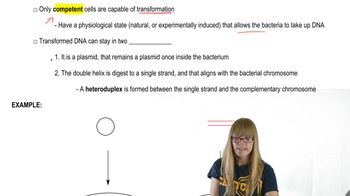In this chapter, we focused on how gene mutations arise and how cells repair DNA damage. At the same time, we found opportunities to consider the methods and reasoning by which much of this information was acquired. From the explanations given in the chapter,
How do we know that mutations occur randomly?
Ch. 15 - Gene Mutation, DNA Repair, and Transposition
Chapter 15, Problem 1
In this chapter, we focused on how gene mutations arise and how cells repair DNA damage. At the same time, we found opportunities to consider the methods and reasoning by which much of this information was acquired. From the explanations given in the chapter, How do we know that certain chemicals and wavelengths of radiation induce mutations in DNA?
 Verified step by step guidance
Verified step by step guidance1
Understand that mutations are changes in the DNA sequence that can be caused by external factors such as chemicals and radiation.
Recognize that scientists use controlled experiments to expose cells or organisms to specific chemicals or radiation and then observe the resulting changes in DNA.
Learn that researchers often use model organisms, like bacteria or fruit flies, to study mutations because they have short generation times and their genetic makeup is well understood.
Identify that techniques such as DNA sequencing and gel electrophoresis are used to detect and analyze mutations in the DNA after exposure to mutagens.
Acknowledge that statistical analysis is employed to determine whether the observed mutations are significantly different from those occurring naturally, indicating that the chemical or radiation is indeed a mutagen.

Verified video answer for a similar problem:
This video solution was recommended by our tutors as helpful for the problem above.
Video duration:
2mWas this helpful?
Key Concepts
Here are the essential concepts you must grasp in order to answer the question correctly.
Mutagenesis
Mutagenesis refers to the process by which genetic mutations are induced in an organism's DNA. This can occur through various agents known as mutagens, which include certain chemicals and physical factors like radiation. Understanding mutagenesis is crucial for recognizing how environmental factors can lead to changes in genetic material, potentially resulting in diseases such as cancer.
Recommended video:
Guided course

Induced Mutations
DNA Repair Mechanisms
Cells possess intricate DNA repair mechanisms that correct damage caused by mutations. These mechanisms, such as nucleotide excision repair and homologous recombination, are essential for maintaining genomic stability. By studying these processes, scientists can understand how cells respond to mutagens and the effectiveness of these repair systems in preventing the propagation of mutations.
Recommended video:
Guided course

Repair Pathways
Experimental Evidence
The relationship between mutagens and DNA mutations is established through experimental evidence, including in vitro and in vivo studies. Techniques such as Ames tests, which assess the mutagenic potential of chemicals using bacteria, and controlled exposure experiments with radiation help demonstrate how specific agents induce mutations. This evidence is critical for regulatory assessments and understanding the risks associated with various environmental exposures.
Recommended video:
Guided course

Transformation
Related Practice
Textbook Question
489
views
Textbook Question
In this chapter, we focused on how gene mutations arise and how cells repair DNA damage. At the same time, we found opportunities to consider the methods and reasoning by which much of this information was acquired. From the explanations given in the chapter,
How do we know that DNA repair mechanisms detect and correct the majority of spontaneous and induced mutations?
458
views
Textbook Question
Write a short essay contrasting how these concepts may differ between bacteria and eukaryotes.
261
views
Textbook Question
Price et al. [(1999). J. Bacteriol. 181:2358–2362] conducted a genetic study of the toxin transport protein (PA) of Bacillus anthracis, the bacterium that causes anthrax in humans. Within the 2294-nucleotide gene in 26 strains they identified five point mutations—two missense and three synonyms—among different isolates. Necropsy samples from an anthrax outbreak in 1979 revealed a novel missense mutation and five unique nucleotide changes among ten victims. The authors concluded that these data indicate little or no horizontal transfer between different B. anthracis strains.
Which types of nucleotide changes (missense or synonyms) cause amino acid changes?
305
views
